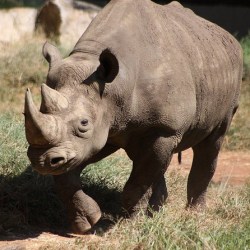Zimbabwe To Re-Introduce Rhinos Into National Parks

Zimbabwe is set to reintroduce rhinos into its second largest national park despite the fact that elephant poaching in the Gonarhezhou reserve is surging. The park which measures 5,053 square-kilometres will introduce 40 black rhinos over two years according to , Hugo van der Westhuizen of the Frankfurt Zoological Society which is working with the Zimbabwean authorities on the project.
“We would want to grow the number to a big number, but first we still have to address the issue of manpower on the ground. There is a lot of pressure of poachers coming from the Mozambican side.” Dr. van der Westhuizen said.
Only 700 rhinos left in Zimbabwe
Rhinos disappeared from the park during the 1930’s and 40’s due to hunting. There was an attempt to reintroduce the species during the 1970’s however those animals were killed by poachers and the species vanished from the region again by the beginning of the 90’s. There are 700 rhinos left in Zimbabwe today.
Poachers hunting rhino’s into extinction
Poachers coming in from Mozambique are already hunting the park’s population of elephants and this year have killed between 25-30 animals. Last year the park lost just 10 elephants according to Aaron Manyawi, a park ranger. Whilst elephants are primarily hunted for their ivory tusks, rhinos are targeted for their horns which many people in South East Asia erroneously believe cures cancer. Last year South Africa’s Kruger National Park lost 800 rhinos mainly to poachers crossing the border from Mozambique.
Conservation has had some success
Poachers don’t just shoot the animals, they also lace waterholes with poison Mr. Manyawi said. In Zimbabwe’s Malilangwe Trust which is a private conservancy that contains both white and black rhinos, there are as many as 80 rangers that protect the animals through regular patrols. The white rhino is much larger than their black cousins.
Park numbers growing
The constant patrolling means that all the rhinos in the park are consistently tracked and identified. The trust has declined to reveal the exact number of rhinos in the park however they did say the population was growing by 8.6 per cent a year.
“We have had problems with poachers, but the situation is under control because of the effective conservation methods we have,” he said. “We still believe having men on the ground is the most effective way.” A spokesperson for the park said.



